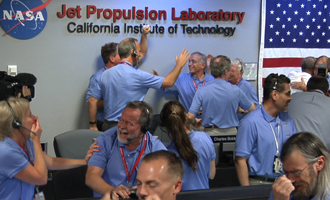PASADENA, Calif. — NASA’s most advanced Mars rover, Curiosity, has landed on the Red Planet. The one-ton rover, hanging by ropes from a rocket backpack, touched down onto Mars recently to end a 36-week flight and begin a two-year investigation.
The Mars Science Laboratory spacecraft that carried Curiosity succeeded in every step of the most complex landing ever attempted on Mars, including the final severing of the bridle cords and flyaway maneuver of the rocket backpack. Curiosity landed at 10:32 p.m. Aug. 5, PDT, (1:32 a.m. EDT Aug. 6) near the foot of a mountain three miles tall and 96 miles in diameter, inside Gale Crater.Mission
During a nearly two-year prime mission, the rover will investigate whether the region ever offered conditions favorable for microbial life.
“The Seven Minutes of Terror has turned into the Seven Minutes of Triumph,” said NASA associate administrator for science, John Grunsfeld.Images
Curiosity returned its first view of Mars, a wide-angle scene of rocky ground near the front of the rover. More images are anticipated in the next several days as the mission blends observations of the landing site with activities to configure the rover for work and check the performance of its instruments and mechanisms.
“Today, the wheels of Curiosity have begun to blaze the trail for human footprints on Mars,” declared NASA administrator Charles Bolden. “Curiosity, the most sophisticated rover ever built, is now on the surface of the Red Planet, where it will seek to answer age-old questions about whether life ever existed on Mars — or if the planet can sustain life in the future.” Confirmation of Curiosity’s successful landing came in communications relayed by NASA’s Mars Odyssey orbiter and received by the Canberra, Australia, antenna station of NASA’s Deep Space Network.Tools
Curiosity carries 10 science instruments with a total mass 15 times as large as the science payloads on the Mars rovers Spirit and Opportunity. Some of the tools are the first of their kind on Mars, such as a laser-firing instrument for checking elemental composition of rocks from a distance.
The rover will use a drill and scoop at the end of its robotic arm to gather soil and powdered samples of rock interiors, then sieve and parcel out these samples into analytical laboratory instruments inside the rover. To handle this science toolkit, Curiosity is twice as long and five times as heavy as Spirit or Opportunity. The Gale Crater landing site places the rover within driving distance of layers of the crater’s interior mountain. Observations from orbit have identified clay and sulfate minerals in the lower layers, indicating a wet history.STAY INFORMED. SIGN UP!
Up-to-date agriculture news in your inbox!











wow. just now reporting this?